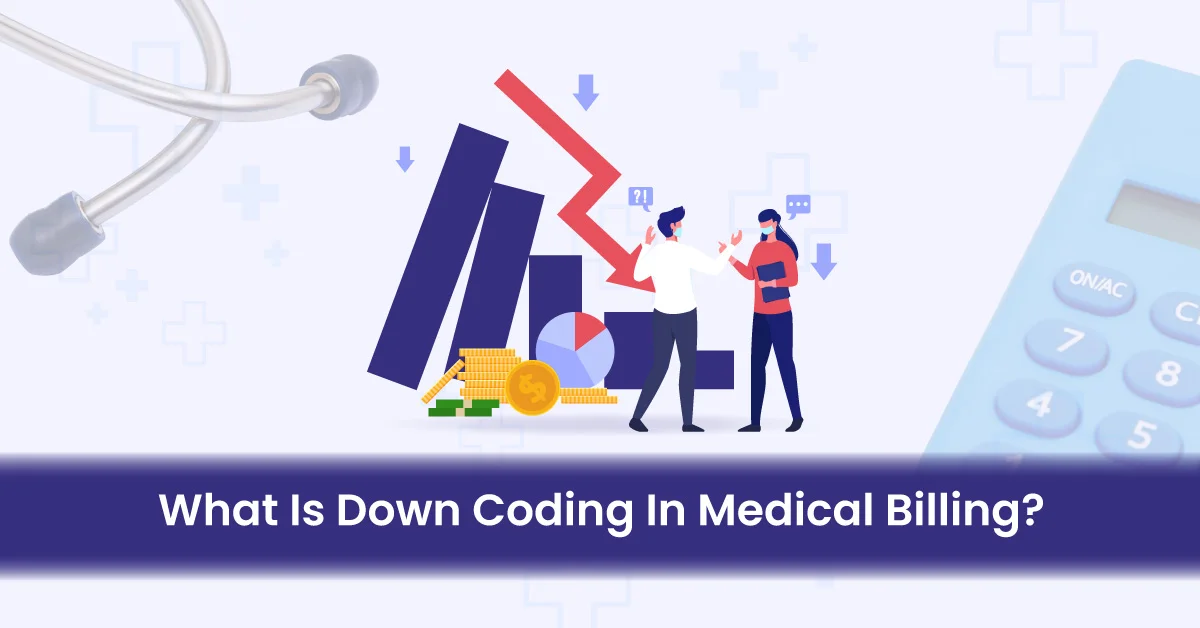The medical biller can bill for services provided based on the medical coder’s report. Claim submissions can be made electronically, reducing the risk of error. Incorrect coding and billing have an impact on the status of a claim. Medical billing mistakes can result in a patient’s treatment being coded as a procedure not covered by insurance, causing them to be denied. This happens dues to inappropriate denial management. Making even minor errors can result in significant time lost tracking down the source of errors and serious patient payments delays. Many studies focused on factors influencing physician accuracy in medical billing and coding errors in patient care.
What is down coding in medical billing? Down coding is where medical services or procedures are coded at a lower level than the service or procedure is medically documented or supported. Down coding can have a serious impact on both physicians and patients. In this article, we will explore what is down coding in medical billing, how it affects patients and physicians, and how you can protect yourself from down coding.
Down Coding Contradicts your Practice
Down coding is a term used in the medical field to describe the act of coding service or procedure at a lower level than what the service or procedure is medically documented or supported. Down coding can seriously impact physicians and patients, as it can lead to reduced payments from insurance companies and incorrect billing. In this article, we will explore the concept of down coding and how it can impact both physicians and patients. We will also discuss how down coding can be prevented and what physicians can do if they believe that their services have been down-coded incorrectly.
Down coding or under coding is the omission of supporting document details required to provide the highest level of specificity for a diagnosis, service, or procedure. Down coding is a serious contradiction with healthcare practices. Providers who routinely down-code their claims should be aware that this practice can harm revenues by reducing or eliminating reimbursement that should have been received. Here you somehow get the concept of what is down coding in medical billing. Furthermore, we will explain how down-coding and up-coding concepts are different.
Difference Between Down Coding and Up Coding
Up coding and down-coding are issues that medical professionals and patients alike are concerned about for several reasons. For those unfamiliar with the specific information on this topic, we’ll take a step back and clarify what it means.
What it all Mean?
Medical coders allocate CPT codes (current procedural terminology) to convey information about a service or procedure performed by a healthcare provider.
Down coding
Down coding occurs when the documented code is at a lower level of intricacy or cost than what is accredited and mentioned. Down coding may also be motivated to avoid claim denials or audits.
Up coding
Alternatively, up-coding occurs when a code is recorded for an advanced level service or procedure rather than what is accredited and mentioned in the patient’s record.
Difference
Up coding and down coding are two different sides of medical coding that can have serious consequences for healthcare providers and patients. Up coding, is a fraud case in which payers are charged for more expensive medical interventions that are provided. It may enforce several federal and state laws, resulting in severe legal and financial implications for providers. Incorrect information can also taint the patient’s medical record. Down coding, however, has traditionally been well-defined as billing a customer for an inferior level of health service than the care provided. This could be due to transcription errors, improper documentation, and misinterpretation of how to bill certain cases or a misguided provider strategy to forgo denials.
Reasons for Down coding
Neglect Coding Errors
Major coding errors lead to down coding, directly affecting patient care. Every practice strives to provide quality patient care as a core component. Incorrect medical coding can set off a chain of proceedings that taints the lasting association with esteemed customers. In addition to affecting reimbursement and incorrect coding can distract the patient’s treatment. Consider what transpires when referring a patient or obtaining insurance authorization when the diagnosis code is incorrect. There are minor differences in the codes that indicate the specificity of each medical diagnosis. When incorrect codes are used during diagnosis, the diagnosis, and care provided at a referral source or other healthcare provider may be incompatible or insufficient for treating the concern.
Inadequate Coding Practices
The providers enter the healthcare field to provide care and improve the lives of patients. Coding is the way that informs third-party insurance payers of the particular treatment being condensed, including diagnosis and other medical care services. When you acquiesce a reimbursement request, the ICD-10 and CPT codes state the insurer what you did and why.
When claims are submitted with incorrect codes, a chain of events occurs in which insurance payers end up reimbursing little bit or much more considerably or denying the claims entirely. The lack of proper denial management paved the path for claim denials. Inadequate coding practices lead to down coding. This down coding provides a platform to lose revenue.
Intentional or Careless Coding
Another major reason for down coding is intentional or careless coding. Intentional coding paves a path for fraud or abuse. Repetitive submissions of claims with coding errors or improper codes, such as up coding, down coding, or imprecise bundling, intentional or careless, can result in fines or federal penalties for deception or misuse. The False Claims Act (FCA) is the implementation tool for deceitful claims, and the concerns can contain a financial penalty or legitimate consequences if the claim is considered fraudulent. To establish fraud rather than abuse, the down coding or miscoding must be repeated many times across many patients.
Need to stop down Coding
Down coding, is a risky approach that can have very negative impact. Practitioners who down code, for example, may be more likely to face an audit if their services are consistently below average. Alternatively, suppose the patient requires more extensive treatment later. In that case, the practitioner may be questioned and even found liable for failing to describe precise details of the treatments in an intricate condition. There’s a need to stop down coding. You can stop down coding by following some preventive measures.
Impact of Down Coding
Impact on patients
Down coding have following impacts on patients:
Impedes patient safety
Medical coding as a system relies on reliability and accuracy, which directly impedes patient safety. Even a simple error, like substituting the positions of two digits in a code during the approval procedure, can result in a remarkably divergent patient treatment. This can result in claim rejections, revenue loss, and a negative patient experience.
Affect patient satisfaction
Medical coding or billing errors can harm your patients’ experiences outside the office, harming your reputation. If a patient receives a large bill for a procedure they did not have, they may suspect a scam. Coverage may be denied if the listed service does not correspond to the client’s claim or is not covered by their policy. Patients who become in debt as a result of your clinic’s mistakes
Impact on healthcare practices
Down coding have following impact on healthcare practices:
Increase administrative time
When incorrect billing inevitably happens, top-level professionals must handle damage control. Cleaning up these errors is an unproductive use of time that could be better spent on problems that are more applied. That can intensify and create a burden on administrative staff.
Lead to fraud
If your healthcare practice fails to acknowledge the error and attempts to correct it, the recipients of the erroneous bill may file a fraud claim. The authenticated medical claims billing service avoids fraudulent claim submissions. Your practice could face damages and other concerns if incorrect charges are filed.
Low reimbursement
Inaccurate coding leads to incorrect billing, which can significantly impact a clinic’s bottom line. Lower reimbursements will result from inaccurately down-coding a key procedure as somewhat accurate.
Tips To Prevent Down Coding
Do not get caught in the trap of down coding to be on safer side. Your physician is responsible for making sure coding is based on your documentation. If you linger to down code, you are only at risk of dropping thousands of greenbacks in revenue. Here are some tips to prevent down coding or to get away from down coding scams.
Systematic Insurance Verification
With comprehensive insurance verification, you can better explain each insurance company’s claim processing and all of the codes they accept. This can assist you in ensuring that you are correctly coding the claims and delivering all supporting information.
Improve Documentation
As previously stated, down coding usually occurs due to not providing adequate details about the services performed. Initial appointment notes alone are often inadequate to convey the intricacies of a patient’s medical history and the physician’s prescription and other decisions
Documentation Audits
Perform coding audits for down coding, share audit findings, integrate auditor suggestions, and educate providers in your practice. This would keep you from submitting claims that contained down coding errors.
Select Software Wisely
Rather than blindly accepting the codes your medical billing software suggests, consider seeking assistance from qualified and knowledgeable coders like we have at BellMedEx. Medical coding and submission can be sped up by using the right EHR. However, you should contact a professional to ensure precision in the document.
Use the Proper Tools
Electronic code look-up systems and applications can identify procedure components that should be aggregated. They can also determine when modifier codes should be used to provide additional indication about techniques. This can aid in achieving maximum reimbursement.
Keep Informed
A major pitfall is keeping up with updated coding guidelines and policies. During audits of some practices, this can help avoid down coding in medical practices.
Conclusion
In medical billing and coding companies, we must report the procedure using a numerical CPT code. These are the most important aspects of medical coding to understand. ICD 10 codes are used to report diagnoses in medical reports, and CPT codes are used to report processes. Up coding and down coding are associated with medical codes in charge of billing or payment of medical claims.
Fraud is used to refer to both up-coding and down-coding. This all can be done to earn extra money or dollars by committing these crimes. Now you have a complete insight into what is down coding in medical billing. The main consequence of up coding and down coding can be claim denial. All medical claims can be denied if medical codes are not reported precisely. Incorrect coding can also cause issues with medical billing processes. So avoid all these down coding issues, follow tips, and recognize the main reasons for down coding by outsourcing medical billing companies.





